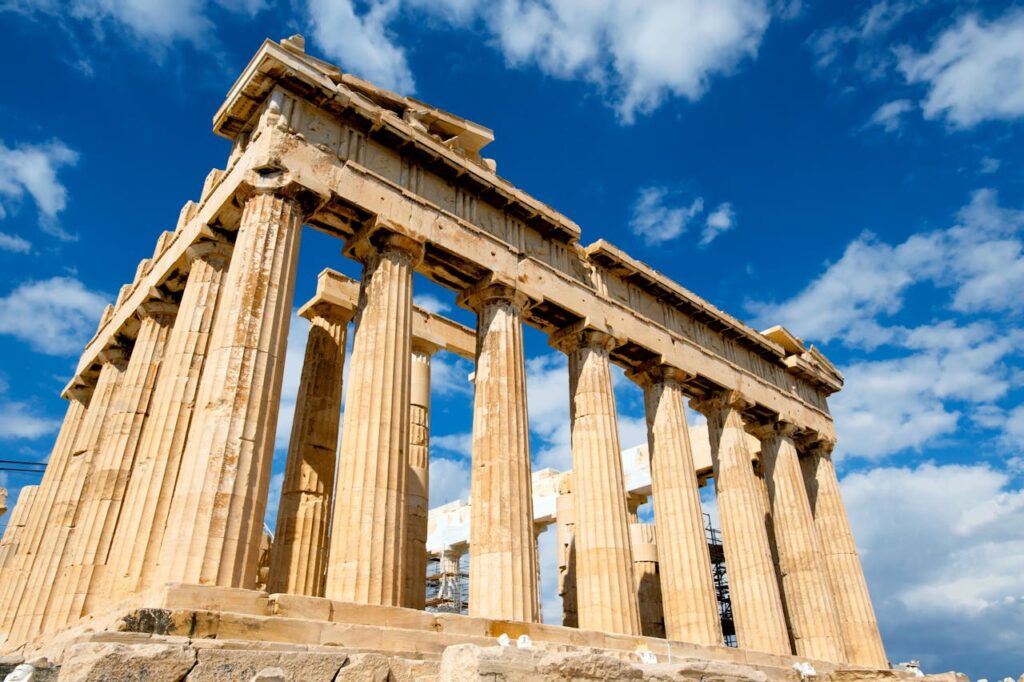
Explore & Play
Discover interesting topics and solve the accompanying crossword puzzle.
Building Crossword | Architectural Marvels Around the World
Table of Contents
Welcome to our exploration of architectural marvels! Before diving into the article, you have the option to engage with the Building crossword first. This interactive challenge will test your knowledge of iconic structures from around the world. If you’re not yet familiar with the topic, feel free to read the article first and then return to tackle the crossword for a deeper understanding. Enjoy your journey through the fascinating world of architecture!
Building Crossword
You can either fill in the crossword puzzle directly on this page or click the button in the bottom right corner to print it for free.

Architectural Marvels of the World: From Ancient Wonders to Modern Icons
From towering skyscrapers to ancient temples, the architectural wonders of the world reflect humanity’s ingenuity, creativity, and cultural heritage. These iconic structures have left an indelible mark on the landscape and on history itself. In this article, we’ll embark on a global journey to uncover the stories behind some of the most remarkable buildings ever constructed, from ancient relics to cutting-edge modern designs. Along the way, you can test your knowledge by completing a Building crossword puzzle that features these legendary sites.
1. Ancient Wonders: Relics of a Bygone Era
These ancient buildings, still standing today, remind us of the architectural mastery of civilizations long past. From temples to tombs, these structures carry the weight of history, showcasing timeless craftsmanship and serving as reminders of our ancestors’ legacies.
1.1. The Great Pyramid of Giza: The Last of the Seven Wonders
The Great Pyramid of Giza is a testament to the engineering skill of the ancient Egyptians. Built as a tomb for Pharaoh Khufu around 2560 BC, it was the tallest man-made structure for over 3,800 years. Its precise alignment with the cardinal points and the massive limestone blocks used in its construction continue to amaze historians and architects alike.
1.2. The Parthenon: Greece’s Symbol of Democracy
Overlooking Athens from its perch atop the Acropolis, the Parthenon stands as a symbol of Ancient Greece’s intellectual and cultural achievements. Built between 447 and 432 BC, this temple dedicated to the goddess Athena exemplifies the beauty of Doric architecture, with its harmonious proportions and intricate sculptures depicting mythological scenes.
1.3. The Colosseum: Rome’s Engineering Marvel
Once the heart of ancient Roman entertainment, the Colosseum is an architectural and engineering masterpiece. Completed in 80 AD, it could hold up to 80,000 spectators and hosted gladiatorial contests, animal hunts, and even naval battles. The elliptical structure, with its tiered seating and complex system of vaults, remains an iconic symbol of Roman grandeur.
1.4. Chichen Itza: The Mayan Architectural Masterpiece
Rising from the Yucatán Peninsula, Chichen Itza is a stunning example of Mayan architectural and astronomical prowess. El Castillo, the central pyramid, is designed to align with solar events, creating an impressive shadow play during the equinoxes. This ancient site, built around 600 AD, served as a ceremonial and economic hub for the Maya civilization.
1.5. Petra: The Rose-Red City Carved Into Stone
Carved directly into pink sandstone cliffs, Petra is one of the most unique cities in the ancient world. Located in present-day Jordan, it flourished around the 1st century AD as a key trading post for the Nabataean Kingdom. The city’s rock-cut tombs and temples, particularly the iconic Treasury, display a remarkable blend of Hellenistic and Near Eastern architecture.
2. Spiritual Icons: Temples, Churches, and Mosques
From ancient temples to modern-day churches, religious buildings are often the heart of a community, representing faith, culture, and architectural beauty. These spiritual icons have transcended time, inspiring awe and devotion in believers and admirers alike.
2.1. Saint Peter’s Basilica: The Heart of the Vatican
At the center of Vatican City, Saint Peter’s Basilica stands as one of the most important and magnificent churches in the Christian world. Built over the tomb of Saint Peter, it boasts grand Renaissance architecture, with its soaring dome designed by Michelangelo. This basilica serves as a pilgrimage site for millions of Catholics each year and a symbol of the Vatican’s spiritual authority.
2.2. Hagia Sophia: From Church to Mosque and Beyond
Hagia Sophia’s vast, dome-topped silhouette has dominated Istanbul’s skyline for nearly 1,500 years. Originally constructed as a Byzantine cathedral in 537 AD, it became a mosque in the 15th century and now serves as a museum. Its combination of Christian and Islamic elements, along with its massive dome and intricate mosaics, make it one of the world’s most architecturally significant buildings.
2.3. Angkor Wat: The Largest Religious Monument in the World
Angkor Wat, located in Cambodia, is the largest religious structure ever built. Originally constructed in the early 12th century as a Hindu temple dedicated to Vishnu, it later became a Buddhist temple. Its massive scale, intricate bas-reliefs, and alignment with celestial phenomena make it a symbol of Cambodia and a marvel of Khmer architecture.
2.4. Notre-Dame de Paris: A Gothic Masterpiece
Notre-Dame, with its dramatic flying buttresses and intricate stained-glass windows, is one of the most famous examples of French Gothic architecture. This Parisian cathedral, completed in the 14th century, has witnessed centuries of history, from coronations to revolutions. Though damaged by fire in 2019, restoration efforts continue to preserve its legacy for future generations.
2.5. The Shwedagon Pagoda: A Buddhist Landmark in Myanmar
Rising 99 meters over Yangon, the Shwedagon Pagoda is Myanmar’s most sacred Buddhist site. Its golden stupa, encrusted with diamonds and other precious gems, is said to contain relics of four previous Buddhas. This glistening monument is a site of pilgrimage and meditation, reflecting Myanmar’s deep Buddhist heritage.
2.6. The Forbidden City: The Heart of China’s Imperial Past
Located in Beijing, the Forbidden City was the imperial palace of Chinese emperors for nearly 500 years. Built in the early 15th century, it consists of nearly 1,000 buildings spread over 180 acres, showcasing traditional Chinese palatial architecture. Its red and gold hues, intricate carvings, and layout symbolize the emperor’s divine authority.
3. Castles and Palaces: Monuments of Power
Castles and palaces around the world have long symbolized the might and wealth of rulers, standing as both military strongholds and opulent homes. These structures are the epitome of grandeur, reflecting the power of the individuals who once occupied them.
3.1. The Alhambra: A Palace of Moorish Grandeur
Perched on a hill overlooking Granada, Spain, the Alhambra is an exquisite example of Islamic architecture. Originally constructed as a fortress in the 9th century, it became a royal palace for the Nasrid Dynasty. The palace’s intricate stucco work, beautiful courtyards, and reflecting pools create a serene and otherworldly atmosphere.
3.2. Neuschwanstein Castle: The Inspiration for Fairy Tales
Nestled in the Bavarian Alps, Neuschwanstein Castle is a fantastical creation that looks as if it’s been plucked from the pages of a storybook. Built in the 19th century by King Ludwig II of Bavaria, it was intended as a personal retreat, though it is most famous today as the inspiration for Disney’s Sleeping Beauty Castle.
3.3. The Kremlin: Russia’s Political and Architectural Center
At the heart of Moscow, the Kremlin has served as the political and religious center of Russia for centuries. With its imposing red brick walls, golden domes, and historic cathedrals, it is both a UNESCO World Heritage site and the seat of Russian power.
3.4. Buckingham Palace: A Symbol of British Monarchy
Buckingham Palace has been the residence of the British monarch since Queen Victoria’s reign. Known for its opulent interiors and the daily Changing of the Guard ceremony, the palace is not only a home but also a symbol of British heritage and continuity.
3.5. The Palace of Versailles: Opulence in France
Versailles, just outside of Paris, epitomizes the grandeur of the French monarchy. Originally a hunting lodge, King Louis XIV transformed it into an opulent palace. The Hall of Mirrors, expansive gardens, and ornate decor make it one of the most luxurious and celebrated palaces in the world.
4. Modern Marvels: The Rise of Skyscrapers and Contemporary Designs
While ancient structures laid the foundation, modern architecture pushes the boundaries of engineering and design. These contemporary buildings reflect the evolution of technology, creativity, and the boldness of modern-day visionaries.
4.1. Burj Khalifa: The World’s Tallest Skyscraper
Soaring 828 meters above Dubai, the Burj Khalifa is a testament to what modern engineering can achieve. Completed in 2010, it is not only the tallest building in the world but also a symbol of Dubai’s rapid transformation into a global city.
4.2. The Sydney Opera House: A Modern Design Icon
With its distinctive sail-like shells, the Sydney Opera House is one of the most recognizable buildings in the world. Completed in 1973, its innovative design by Danish architect Jørn Utzon revolutionized modern architecture and earned it a UNESCO World Heritage designation.
4.3. One World Trade Center: A Symbol of Resilience
Built on the site of the original Twin Towers in New York City, One World Trade Center symbolizes resilience and renewal. At 1,776 feet, it is the tallest building in the Western Hemisphere, designed to commemorate the lives lost during the 9/11 attacks and to look forward with optimism.
4.4. The Guggenheim Museum: Frank Lloyd Wright’s Curves
Frank Lloyd Wright’s Guggenheim Museum in New York City redefined modern museum architecture. With its spiraling form, it challenges the traditional notion of museum layouts and invites visitors to experience art in a whole new way.
4.5. The Shard: London’s Tallest Building
The Shard’s unique glass façade and soaring height make it a defining feature of London’s skyline. Completed in 2012, this mixed-use skyscraper offers stunning views from its observation deck, showcasing the city’s rich history and vibrant life.
5. Engineering Feats: Pushing the Limits of Construction
From overcoming geographical challenges to inventing new materials, these architectural wonders represent human ingenuity at its finest. They demonstrate how innovative thinking can lead to groundbreaking designs and solutions.
5.1. The Leaning Tower of Pisa: Defying Gravity for Centuries
The Leaning Tower of Pisa has captivated visitors with its unintended tilt since its construction in the 12th century. Originally built as a freestanding bell tower, the structure’s lean is a result of unstable foundation soil. Despite this flaw, it has become a symbol of architectural ingenuity and perseverance.
5.2. The Eiffel Tower: A Monument to Modernity
Constructed for the 1889 Exposition Universelle, the Eiffel Tower was initially met with skepticism but has since become a beloved icon of Paris. Standing at 324 meters, this wrought-iron lattice tower exemplifies the industrial age’s spirit and has welcomed millions of visitors who admire its design and stunning views.
5.3. The Qutub Minar: A Towering Victory of Islamic Architecture
The Qutub Minar in Delhi, India, is the tallest brick minaret in the world, standing at 73 meters. Built in the 12th century, it showcases the intricate artistry of Indo-Islamic architecture and remains a UNESCO World Heritage site, reflecting the region’s rich cultural heritage.
5.4. The Panama Canal: A Man-Made Wonder of Engineering
Connecting the Atlantic and Pacific Oceans, the Panama Canal is a marvel of engineering that has revolutionized global trade since its opening in 1914. Its system of locks allows ships to navigate the significant elevation change, exemplifying human ingenuity in overcoming geographical barriers.
6. Cultural Symbols: Buildings that Define a Nation
Certain buildings have transcended their architectural significance to become enduring symbols of national pride and culture. These structures represent the identity and history of their nations, embodying the spirit of their people.
6.1. The White House: The Home of the U.S. President
The White House serves not only as the residence of the President of the United States but also as a symbol of democracy and governance. Built in the 18th century, its neoclassical architecture and iconic facade have made it a central figure in American history and politics.
6.2. The Taj Mahal: India’s Eternal Symbol of Love
The Taj Mahal is a stunning mausoleum built by Mughal Emperor Shah Jahan in memory of his beloved wife, Mumtaz Mahal. Completed in 1648, its breathtaking beauty, symmetrical gardens, and intricate marble inlay work have earned it a place as a UNESCO World Heritage site and a symbol of eternal love.
6.3. The Sagrada Familia: Barcelona’s Unfinished Masterpiece
Antoni Gaudí’s Sagrada Familia is an architectural wonder that has been under construction since 1882. Its unique combination of Gothic and Art Nouveau styles, along with its ambitious design, reflects Gaudí’s deep spirituality and vision. Despite its unfinished state, it remains one of the most visited monuments in Spain.
6.4. Saint Mark’s Basilica: A Venetian Masterpiece
Saint Mark’s Basilica, located in the heart of Venice, is a stunning example of Italo-Byzantine architecture. Its dazzling mosaics and intricate design tell the story of Venice’s rich history and its connection to the Byzantine Empire, making it a symbol of Venetian culture and pride.
Celebrating Our Architectural Legacy
From ancient temples to modern skyscrapers, these architectural marvels serve as enduring symbols of humanity’s creativity, resilience, and ambition. They inspire awe and wonder, reminding us of the incredible achievements possible when art, engineering, and culture intertwine.
Now that you’ve explored these iconic structures, why not put your knowledge to the test? Challenge yourself to complete the Building crossword puzzle and discover how many architectural wonders you can name!
Share to...
I hope you enjoy the content.
Want to receive our daily crossword puzzle or article? Subscribe!
You may also be interested in
Share to…
Want to receive our daily crossword puzzle?
-
Jigsaw Puzzles
Elegant Pig Zodiac Watercolor Jigsaw Puzzle 250 | 300 | 500 Brikker
kr 348,00 – kr 439,00 Select options This product has multiple variants. The options may be chosen on the product page -
Jigsaw Puzzles
Autumn Whiskers and Pumpkin Paws Puzzle 250 | 300 | 500 Pieces
kr 348,00 – kr 439,00 Select options This product has multiple variants. The options may be chosen on the product page -
Jigsaw Puzzles
Fjord Elegance: Abstract Jigsaw Puzzle 250 | 300 | 500 Pieces
kr 348,00 – kr 439,00 Select options This product has multiple variants. The options may be chosen on the product page

















